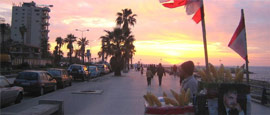Travel to Beirut
Flying to Beirut
British Airways and Middle East Airlines offer direct flights from London to Beirut. These can be expensive compared to flights to other destinations a similar distance away however, so it's worth considering indirect flights. Airlines offering an indirect service via other cities include Pegasus Airlines, Turkish Airlines, Lufthansa, Air France and Alitalia.
From London - 4 hours 30 minutes; New York - 12 hours 30 minutes (including stopover); Los Angeles - 17 hours 30 minutes (including stopover); Toronto - 12 hours 30 minutes (including stopover); Sydney - 20 hours 30 minutes (including stopover).
Website:www.beirutairport.gov.lb
Location:
Beirut Rafic Hariri International Airport is located 9km (6 miles) south of Beirut city centre.
Money:
A BankMed offering currency exchange services and ATMs is available in the terminal.
Luggage:
Airport security desks (tel: +961 1 628 000) provide lost luggage tracking services – passengers must first collect a paper slip verifying their loss from the arrival hall. Baggage wrapping services are available in the check-in area.
Travel by road
Driving in Lebanon can, quite frankly, be a terrifying experience thanks to the dodgy condition of the roads and the maniacal drivers. Taxis are plentiful and very cheap, so are usually the best bet, but if you do decide to get behind the wheel, there are plenty of rental cars available. Rental cars (and fuel) are expensive and can be in poor repair and you will need a valid International Driving Permit and a carnet de passage to hire one.
Traffic drives on the right. Speed limits are 50kph (31mph) in urban areas and 100kph (62mph) on major highways.
Roads within Beirut are usually choked with traffic, particularly during rush hour, and it can take as long as an hour just to complete a 20-minute journey. Beirut’s roads often contain potholes, even in restored areas, while outside of the city, things are even worse.
Sodepex (SOS Auto) (tel: +961 4 400 678).
There are three major highways that lead to Beirut: the first is the road to Tripoli on the northern tip of Lebanon. It cuts through the Christian towns of Byblos and Jounieh. To the south is the road to Tyre, which passes through the historic port of Sidon. Finally, the most commonly used road is the scenic Beirut-Damascus route, which winds along the Lebanon Mountains. The latter is extremely hazardous and in very poor condition.
From Tripoli - 1 hour 30 minutes; Sofar - 40 minutes; Damascus - 3 hours; Amman - 5 hours.
Regular bus services which connected Beirut with the Syrian capital, Damascus, used to arrive and depart from an intersection next to Cola Bridge in the southern Mazraa district. However, due to the civil war in neighbouring Syria, this service is currently suspended.
Travel by rail
Although Lebanon once had excellent railways courtesy of its French overlord during the colonial period, subsequent strife and political neglect has left the country without a functioning railway system. The last train to use Lebanese tracks (it carried cement from Chekka to Beirut) was decommissioned in 1997 and in consequence, there are no commercial rail services in or out of the city. Ambitious plans to connect Beirut with the Syrian capital, Damascus, are currently on hold pending the outcome of the ongoing Syrian civil war.
Travel over water
There is no regular public sea transportation to and from Lebanon, although some cruise ships do stop in Beirut during the summer months. Thomson Cruises (tel: +44 20 3451 2682; www.thomson.co.uk) includes Beirut on a couple of its itineraries.
The rest of the traffic through Beirut’s harbour is mainly cargo with most ships arriving in Lebanon from Cyprus. The nearby Port of Jounieh (tel: +961 9 933 818), approximately 15km (9 miles) from Beirut on the Beirut-Tripoli highway, accommodates cruise ships and ferries.
Do you have any Feedback about this page?
© 2026 Columbus Travel Media Ltd. All rights reserved. No part of this site may be reproduced without our written permission, click here for information on Columbus Content Solutions.








 You know where
You know where